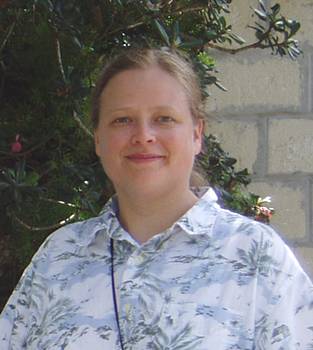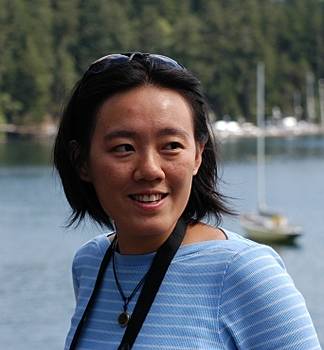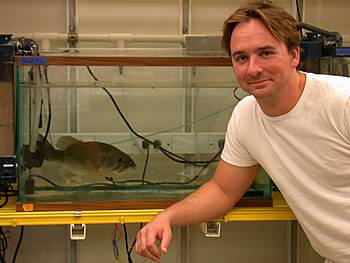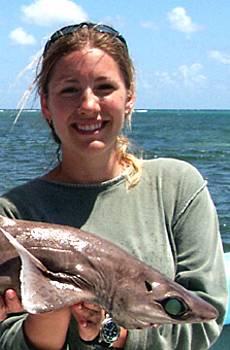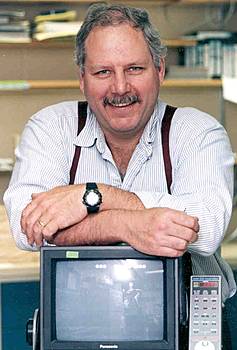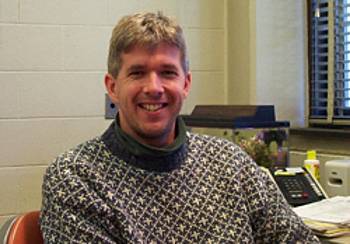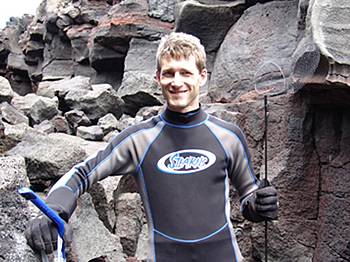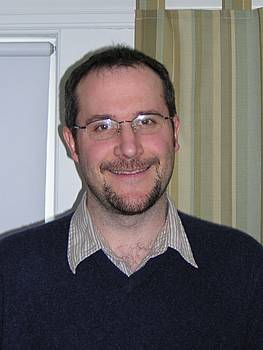
Contents
Message from the President
Sarah A. Woodin
Message from the Treasurer
Ron Dimock
Message from the Program Officer
Catherine Loudon
Message from the Secretary and Business Meeting Minutes
Sunny K. Boyd
Divisional Newsletters
Comparative Endocrinology (DCE)
Comparative Physiology and Biochemistry (DCPB)
Evolutionary Developmental Biology (DEDB)
Division of Vertebrate Morphology (DVM): 2005 Spring Newsletter
In this newsletter:
- Message from the Chair
- Message from the Program Officer
- Message from the Secretary
- Elections: Candidates for DVM Program Officer and Secretary
Message from the Chair
Beth Brainerd
On behalf of DVM, I would like to thank Frank Fish for his service as DVM Chair for the past two years. Now he will have more time for reading and soaking in the bathtub.
Despite unexpectedly poor weather, the San Diego meeting was great. The poster sessions were a particular highlight -- the unopposed afternoon time combined with wide (but still not quite wide enough) spaces between the rows made these poster sessions particularly effective. In the past, DVM has tended to favor oral presentations over posters, but this seems to be changing as members have come to appreciate the small-group interactions in front of posters. As the number of concurrent sessions has increased, posters are now a better way to be sure that one's work is seen by colleagues with the most relevant interests (and one's poster is never scheduled for 8 AM on the last day of the meeting!).
As always, the contributions from graduate students and undergraduates were highlights of the meeting in San Diego. The D. Dwight Davis Prize for best student paper was awarded to Kai-Jung Chi from Duke University for her oral presentation, "Scaling of foot contact area and its mechanical implications for mammals of different foot postures," with Honorable Mention going to Andrew Carroll from UC Davis for "Force transmission during suction feeding in centrarchid fish." The Best Student Poster Prize was awarded to Jill Olin from Hofstra University for her poster "Histological comparison of the retinal structure of deep-water and epipelagic sharks." Congratulations to these winners and thanks to our prize committee: David Carrier, Steve Deban, Nate Kley, Callum Ross, Adam Summers and Roshna Wunderlich.
SICB 2006 will be held in Orlando Florida. The SICB Call for Opening Plenary Speaker Proposals for the Orlando 2006 meeting will be announced in April 2005. In the past there has been one opening speaker, but in San Diego the opening session was a mini-symposium with five speakers on the "Neuron Doctrine." I would like to coordinate a potential proposal for Orlando 2006 from DVM, perhaps in collaboration with other divisions. Please contact me with ideas for the opening session.
The venue for 2007 was undecided as of the meeting in San Diego, but now has been set as Phoenix Arizona (see Message from the SICB President). The Call for Symposium Proposals for Phoenix 2007 will go out in April 2005, with an August 2005 deadline. Due to budget cuts, support from NSF for symposia may be less than in the recent past. I encourage potential symposium organizers to think creatively about funding, perhaps requesting funding from private companies, such as the exhibitors at SICB.
At the DVM business meeting in San Diego, there was overwhelming support for John Bertram's suggestion that our bylaws should be amended to permit the DVM Program Officer to serve two terms. This amendment has been posted for comment, and you will be asked to vote on it soon (see Message from the Secretary, below). Unfortunately the timing is such that we must vote on this change at the same time as we vote for Program Officer Elect; therefore it is not possible to nominate John Bertram for a second term at this time. Thanks to John for his leadership in suggesting this useful change to our bylaws.
Finally, thanks to our 2005 DVM Nominating Committee -- Jeanette Wyneken, Jim Stewart and Bret Tobalske -- for their important work in nominating candidates for Program Officer Elect and Secretary Elect, and thanks also to the nominees for agreeing to serve, if elected. The spirit of volunteerism in DVM is ever strong, demonstrating our appreciation for the roles of DVM in SICB and in fostering research and student training in vertebrate morphology.
Message from the Program Officer
John Bertram
Another year is progressing and it's time to start thinking about preparations for abstract submission for the Orlando meeting. As a recent resident of Florida, I can attest to some of the advantages of the area in early January. Some may wonder about the compatibility of a scientific organization like ours and the theme park culture of Orlando. A large portion of Orlando's service industry is set up to make conventions run well, and they do an admirable job of it. So I am looking forward to great facilities for the meeting. The proximity of a variety of attractions makes it a great place to combine our annual 'work' trip with a memorable family adventure (that will garner points for much time to come). Apart from the city and organized attractions, central Florida has abundant and remarkably available wildlife. I recommend you consider planning some excursions to take advantage of that opportunity, as well.
The annual meeting is shaping up to be another great one. In years past problems associated with the poster sessions have been solved, and I'll work to maintain the afternoon format where discussion at posters are liberally mixed with the general socializing that is so important to our Division. We had difficulties with room size in San Diego, but we now have attendance data that will fortify my arguments in our favor when these things are decided in Sept. We also have two impressive symposia generated by members from our Division. We have sponsored "Biomechanics and Neuromuscular Control" organized by Kiisa Nishikawa and Andy Biewener. For anyone interested in movement this will be an important symposium because it will explore the interaction between direct control strategies and the expressed outcome, which can be related in surprising ways. The Division is also sponsoring "Zebrafish in Comparative Context" organized by Jackie Webb and Tom Schilling. You might think that a focus on a single species is a bit limiting for a comparative context, but the objective of the symposium is actually to bring together the diverse species of scientists (or is it phyla?) using this model that plays an important role in very different research questions and approaches.
Other things to keep in mind:
Great meetings and interesting symposia depend on your creativity. If you have a good idea for a symposium you would like to see, it is necessary to start organizing early. The 2007 meeting will be in Phoenix and it is time to start working on symposia for that. A link to the meeting page can be found on the SICB website (http://www.sicb.org/meetings/2007/index.php3 ) and deadline for symposia proposals for that meeting is Aug. 19.
A final thought for us to consider over the coming months and discuss in Orlando - the Society for Experimental Biology, a comparable group to ours (if even a little broader), meets each year and attracts participants from all over Europe. Previously the society has only met in Britain, but apparently it has recently been taken over by some irreverent young hot-heads who have arranged to experiment with a change of venue - this year it's in Barcelona. This particular experiment has been received so well that there is a murmur that even more audacious changes might be considered. One that has unofficially been floated to me is the possibility of a joint SICB-SEB meeting. Although there are numerous issues to consider with a proposal like this (timing and travel costs are two), having enjoyed both meetings immensely I find this an intriguing idea. Certainly it's worth considering over the coming months so we can chat while standing in line for libations at the poster sessions in Orlando. Now, would Bermuda or the Azores be considered middle ground…? Cheers and have a great summer.
Message from the Secretary
Audrone Biknevicius
Minutes from SICB 2005 (submitted by A.R. Biknevicius)
Malcom Gordon (UCLA) drew attention to the 2005 International Union of Physiological Science Congress to be held 31 March - 5 April 2005 and the pre-Congress symposium "Biophysical and biomechanical adaptation and bioengineering" which will cover four major topics: (1) Animal Locomotion, (2) Muscle, (3) Internal Flow and (4) Materials. For information: http://www.iups2005.org/
Bill Zamer (National Science Foundation) provided a brief report for NSF. First, he announced that the Division of Integrative Biology and Neuroscience has been reorganized and that DVM members should take note of the new Division of Integrative Organismal Biology (IOB) which contains four thematic clusters (Behavioral systems; Developmental systems; Environmental and structural systems; Functional and regulatory systems; see divisional website for more information: http://www.nsf.gov/bio/iob/start.htm ). Applicants should identify one or two program officers within the division to get recommendations on the most appropriate cluster for your work. Second, Bill noted that NSF has received a ~5% budget cut, resulting in an expected funding rate in the "low teens" (11-15%). Nevertheless, he encourages DVM members to continue to submit proposals as NSF is trying to maintain research project funding. Hardest hit are programs such as symposia support, with funding in these areas focused on serving new scientists (graduate students, postdocs).
Steven Vogel (Duke University) reported on SICB's Digital Library. He noted that AAAS received a NSF grant for the development of the Bioscience Engineering Network (BEN) to form a set of educational websites containing materials primarily for undergraduate education. SICB is supporting the development of several areas, including biomechanics and environmental endocrinology. Steve invited the DVM membership to submit contributions for biomechanics (text should be in RTF or rich-text format; movies and sound may be included). Submitted materials will be peer-reviewed. Submissions go directly to the website (http://sicb.org/dl/biomechanics.php3 ). Direct inquiries and miscellanxieties to the co-editors: Rachel Merz (rmerz1@swarthmore.edu) or Steve Vogel (svogel@duke.edu). [For more details, see item 3 below]
DVM Program Officer John Bertram (University of Calgary) requested feedback about the San Diego meetings to help in improving future meetings. Although the symposia for the 2006 Orlando meetings are set, there is still interest in more symposia for 2006 in Arizona. Finally, John encouraged DVM members to volunteer to serve as session chairs.
SICB Executive Committee stopped by for a brief visit. John Wingfield, SICB President, noted two items of concern for the society. One was the reduction for symposium support by NSF. Second, he noted the decrease in institutional subscriptions (see below).
Melina Hale (University of Chicago) represented the Integrative and Comparative Biology editorial board. She noted that the board was recently reinstated because of concern over institutional subscriptions. Many journals are published by large publishers that bundle journals for sale to institutions; however, Integrative and Comparative Biology is independently published by SICB and thus is an easy target for cuts when institutional budgets themselves are cut. In order to increase the journal's visibility, SICB has been soliciting help with marketing and is courting several presses to take on the management of the journal (although SICB will retain control on content). The board is also considering changes to the journal's format to supplement symposia publication.
Jeannette Wyneken (Florida Atlantic University) summarized the success of the 7th International Congress of Vertebrate Morphology that was held in 2004:488 participants of which 209 were international, representing 32 countries, and 17 symposia. The ICVM-8 will be held in July 2007 in Paris.
Bret Tobalske (University of Portland) reported for the Nominating Committee. This spring both DVM Secretary and DVM Program Officer positions will have elections. The Secretary's term (2 year) is renewable whereas, under current DVM bylaws, the Program Officer's term (2 year) is nonrenewable. John Bertram noted that the first year as PO has a large learning curve so that peak effectiveness only occurs in year 2 and that he believed that an additional year of service would not be onerous and actually would be beneficial to the division. Dave Carrier agreed. Frank Fish offered a counter proposal to retain the PO term as 2 years but to make it renewable (so to retain its offset with the Chair's terms). A proposal to alter the DVM by-laws was advanced to change Article 8 as follows, from" "The Program Officer shall arrange for the programs of the Division. This person shall serve two years, asynchronous with the Chair-Elect, without eligibility for re-election" to "The Program Officer shall arrange for the programs of the Division. This person shall serve two years, asynchronous with the Chair-Elect, and shall be eligible for one additional term". This proposal was met with unanimous approval by the membership attending the meeting. This proposal will be sent to the entire DVM membership for a web-based discussion followed by an electronic vote.
The item of business was the passing of the gavel from Frank Fish to the new DVM chair, Beth Brainerd. The new chair-elect is Kurt Schwenk (University of Connecticut).
2005 SICB-DVM Student Awards
Once again, the DVM students provided some of the finest contributions at the national meetings. The following students have been recognized for their especially fine studies and presentations.
Davis Award
Kai-Jung Chi
Davis Award - Honorable Mention
Andrew M. Carroll
Poster Award
Jill A. Olin
Davis Award winner Kai-Jung Chi works in the Department of Biology at Duke University (advisor, V. Louise Roth). Her winning presentation ("Scaling of foot contact area and its mechanical implications for mammals of different foot postures") highlighted some of Kia-Jung's interests in comparative biomechanics and physiology, and her work was supported by a NSF Doctoral Dissertation Improvement Grant and numerous Grants-in-Aid of Research.
Andrew M. Carroll's fine presentation ("Force transmission during suction feeding in centrarchid fishes") received an Honorable Mention. Andy's area of research is musculoskeletal function during suction feeding. He is shown above with a largemouth bass (Micropterus salmoides, Centrarchidae) in his advisor Peter Wainwright's lab (Section of Evolution and Ecology at UC Davis).
Jill A. Olin won the DVM poster award for her poster ("Histological comparison of the retinal structure of deep-water and epipelagic sharks"). Jill works on elasmobranch sensory biology with her advisor John F. Morrisey (Department of Biology, Hofstra University). She is pictured above with the deep-water gulper shark (Centrophorus cf. uyato) featured in her research; this specimen was collected on a long-line from the Cayman Trench, Jamaica, West Indies at approximately 800m depth just offshore from the Hofstra University Marine Laboratory.
Please extend a hearty congratulation to all our student awardees!
SICB Digital Library (submitted by Steven Vogel)
A website for teaching material is now on-line for submissions, perusals, and downloadings: http://sicb.org/dl/biomechanics.php3
Sponsorship was provided by SICB via AAAS via NSF. This is the first of a series of such sites that will provide peer-reviewed instructional materials in integrative and comparative biology for use in undergraduate education. Collectively, they'll form the SICB Digital Library, part of the Bioscience Education Network (BEN— http://www.biosciednet.org/portal/). What will the site offer; what might you submit?
Syllabi and descriptions of existing, successful courses in biomechanics Problems for homework assignments and examinations (with answers available in response to specific requests) Inquiry-based learning activities for classroom, laboratory, and home—both hardware-based and computer-based Classroom demonstrations, with instructions for construction and sources of material Annotated lists of useful written material, websites, and software—for specific course use, as well as for background and supplementary reading. Visual material in digital form, including both still and video images, for use in lectures and elsewhere Background modules for relevant physical and mathematical tools, usable as stand-alone documents to distribute to students. Potential individual or class projects, with what references can be provided as background and starting points. PowerPoint presentations. Both specific instructions and general guidance for making and using devices with wider applications in biomechanics teaching. Teaching Biomechanics using the SICB Digital Library provides a new stream of material to structure your course and a way to ensure wide outflow of your own efflux.
SICB-DVM ELECTIONS FOR DIVISIONAL PROGRAM OFFICER
(Candidates listed alphabetically) SICB-DVM will be holding elections for a new divisional program officer this spring. Below are our two candidates (Steve Reilly and Jeff Walker). You will be contacted in a future e-mail from the society office to submit your vote.
Stephen M. Reilly, PhD
Current Position. Associate Professor, Dept. of Biological Sciences, Ohio University, Athens, OH. http://www.biosci.ohiou.edu/faculty/reilly/
Education.
Ph.D. 1986. Southern Illinois University.
M.A. 1980. San Francisco State University.
B.A. 1977. Southern Illinois University.
Professional Experience.
1986 - 1991. NSF Post-doctoral Fellow, University of California Irvine.
1990. Invited Instructor, National Science Foundation workshop Morphometrics in Systematic Biology.
1990. Invited Participant, National Research Council workshop Declining Amphibian Populations.
1980 to present. Research Associate, Departments of Herpetology, California Academy of Sciences and Museum of Natural History, University of Kansas.
1980. Chief Herpetologist, Steinhart Aquarium, California Academy of Sciences, San Francisco.
1978 – 1980. Museum Curator, Museum of Human Evolution, San Francisco State University.
Awards and Honors. Phi Beta Kappa, 1977; Phi Kappa Phi, 1984; Richard E. Blackwelder Award in Zoology, 1984; Sigma Xi, 1987; OU Honors Tutorial College "Tutor of the Year" Award, 1998.
SICB Activities. Chair, contributed paper sessions, DVM (10 times); D. Dwight Davis Award Committee (member twice, chair once); ASZ Symposium co-organizer (Ecological Morphology), 1991; Nominated for DVM Program Officer, 1998. Chair, DVM Nominating Committee, 1999; Nominated for DVM Chair, 2002; Missed 2 meetings since 1986.
Research Interests. Functional morphology and the evolution of vertebrate feeding and locomotion. Experimental and morphometric approaches to the analysis of form and function in organisms. Life history evolution and patterns of heterochrony in amphibians.
Publications. 63 refereed publications
Five most recent publications:
Willey, J.S., Biknevicius, A.R., Reilly, S.M. and K.D. Earls. 2004. The tale of the tail: limb function and locomotor mechanics in Alligator mississippiensis. J. Exp. Biol. 207:553-563.
Reilly, S.M. and R. W. Blob. 2003. Motor control of locomotor hindlimb posture in the American alligator (Alligator mississippiensis). Journal of Experimental Biology 206: 4341-4351.
Parchman, A.J. Reilly, S. M. and A.R. Biknevicius. 2003. Whole-body mechanics and gaits in the gray short-tailed opossum, Monodelphis domestica: integrating patterns of locomotion in a semi-erect mammal. J. Exp. Biol. 206:1379-1388.
Reilly, S.M. and T.D. White. 2003. Hypaxial motor patterns and the function of epipubic bones in primitive mammals. Science 299:400-403.
Larson, P. M. and S.M. Reilly. 2003. Functional morphology of feeding and gill irrigation in the anuran tadpole: Electromyography and muscle function in larval Rana catesbeiana. Journal of Morphology. 255:202-214.
Other Memberships. American Society of Ichthyologists and Herpetologists, Herpetologists League, Society for the Study of Amphibians and Reptiles, World Congress of Herpetology, International Congress of Vertebrate Morphology.
Goals as Program Officer. As the electronic management of contributed talks and posters evolves it should be easier to schedule coherent sessions and control overlap between sessions, divisions, and symposia. As every outgoing program officer says, it is a difficult task, but I think I can squeeze a little more overlap and conflict out of the program for DVM members. Also I want to get a better grip on how the keyword system works and try to both streamline/ improve it and explain to contributors (and add to the web forms) how it works in determining how the program is scheduled. Finally, I plan to take a proactive approach to developing more DVM symposia in light of NSF effectively cutting off funding for them. Perhaps we can encourage organizers and contributors that are already attending the meetings to plan and contribute to new symposia. Following the lead of John Bertram, I would probably serve for two years if our bylaws are amended to allow this.
Jeffrey A. Walker, PhD
Current Position. Assistant Professor of Biology, University of Southern Maine (since 2000) http://www.usm.maine.edu/~walker/
Education.
Ph.D. 1995, Anatomical Sciences, Stony Brook.
B.A. 1988, Geology with Honors, University of Pennsylvania;
Professional Experience.
1995-2000, Postdoctoral fellowships, Field Museum of Natural History, Chicago.
Awards and Honors. NSF Postdoctoral Research Fellowship.
SICB Activities. D. Dwight Davis Award judge (2000, 2002-2003); Chair/Co-chair in a locomotion contributed session (every year).
Research Interests. Integrative functional morphology, ecology, and evolution. Science methodology, including statistics and modeling.
Publications. 26 refereed publications
Five most recent publications:
Walker, J. A. 2004. Kinematics and performance of median and paired fins as control surfaces. IEEE Journal of Oceanic Engineering 29, 572-584.
Westneat, M. W., Thorsen, D. H., Walker, J. A. and Hale, M. E. 2004. Structure, function and neural control of pectoral fins in fishes. IEEE Journal of Ocean Engineering 29, 674-683.
Walker, J. A. 2004. Dynamics of pectoral fin rowing in a fish with an extreme rowing stroke: the threespine stickleback (Gasterosteus aculeatus). Journal of Experimental Biology, 207: 1925-1939.
Ghalambor, C. K., D. N. Reznick, and J. A. Walker. 2004. Constraints on adaptive evolution: the functional trade-off between reproduction and fast start escape performance in the guppy (Poecilia reticulata). American Naturalist, 164:38-50.
Ghalambor, C. K., J. A. Walker, and D. N. Reznick. 2003. Multi-trait selection, adaptation, and constraints on the evolution of burst swimming performance. Integrative and Comparative Biology, 43:431-438.
Goals as Program Officer. I would like to continue the trend of developing highly integrative contributed sessions and symposia that allow scientists from diverse fields but overlapping interests to learn from each other. Similarly, I would also like to continue the recent practice of scheduling poster sessions that do not compete with either afternoon talks or evening social schedules. Finally, I will schedule senior graduate students and especially postdocs into the better-attended sessions occurring earlier in the week in order to give them and their research increased exposure.
SICB-DVM ELECTIONS FOR DIVISIONAL SECRETRAY
(Candidates listed alphabetically) SICB-DVM will be holding elections for a new divisional secretary this spring. Below are our two candidates (Rick Blob and Gary Gillis). You will be contacted in a future e-mail from the society office to submit your vote.
Rick Blob, PhD
Current Position. Assistant Professor, Department of Biological Sciences, Clemson University, Clemson, SC. http://people.clemson.edu/~rblob/
Education.
Ph.D. 1998: University of Chicago (Evolutionary Biology)
B.A. 1992: University of Pennsylvania (Biology, Individualized Studies – Paleobiology)
Professional Experience.
2002-present: Assistant Professor, Department of Biological Sciences, Clemson University (courses taught include Vertebrate Biology, Comparative Vertebrate Morphology, Animal Biomechanics, Vertebrate Paleobiology)
1999-2001: NIH Postdoctoral Fellow, Field Museum of Natural History (Zoology)
1998-1999: Senior Assistant Collections Manager, Field Museum of Natural History (Fossil Mammals)
Awards and Honors. 1992: Henry Darwin Rogers Award in Geology, University of Pennsylvania; 1992: Phi Beta Kappa; 1992: NSF Predoctoral Fellowship; 1997: Society of Vertebrate Paleontology Predoctoral Fellowship; 1998: Best Student Poster, SICB-DVM; 2004: Outstanding Young Researcher, Sigma Xi Clemson Chapter
SICB Activities. 2001, DVM nominating committee; 2002, DVM Davis Award judge; 2003, Chair, DVM Davis Award committee
Research Interests. Evolutionary morphology and biomechanics of the vertebrate musculoskeletal system, with a primary focus on locomotion in reptiles, amphibians, and fishes. Other areas of interest include the evolution of bone mechanical properties, evolution of aquatic/terrestrial habitat transitions, fish and reptile feeding, ontogeny of musculoskeletal function, and biomechanical modeling of functional capabilities in fossil taxa.
Publications. 17 refereed publications
Five most recent publications:
Willey, J. S. and R. W. Blob. 2004. Tail kinematics of juvenile common snapping turtles during aquatic walking. Journal of Herpetology 38(3):360-369.
Schoenfuss, H. L., M. L. Julius, and R. W. Blob. 2004. Colonization of a recent, volcanically formed freshwater habitat: an example of primary succession. Ichthyol. Explor. Freshwaters 15(1):83-90.
Reilly, S. M. and R. W. Blob 2003. Motor control of locomotor hindlimb posture in the American alligator (Alligator mississippiensis). Journal of Experimental Biology 206:4327-4340.
Schoenfuss, H. L. and R. W. Blob. 2003. Kinematics of waterfall climbing in Hawaiian freshwater fishes (Gobiidae): vertical propulsion at the aquatic-terrestrial interface. J. Zool. Lond. 261:191-205.
Westneat, M. W., O. Betz R. W. Blob, K. Fezzaa, W. J. Cooper, W. Lee. 2003. Tracheal respiration in insects visualized with synchrotron X-ray imaging. Science 299:558-560.
Other Memberships. American Society of Ichthyologists and Herpetologists, Herpetological Association of Africa, Herpetologists' League, International Society of Vertebrate Morphology, Sigma Xi, Society for Experimental Biology, Society for the Study of Amphibians and Reptiles, Society of Systematic Biologists, Society of Vertebrate Paleontology
Goals as Secretary. As DVM Secretary, I will ensure that communication between the SICB office, DVM officers, and DVM members continues to be timely and informative. I also think that DVM can work to advance some important goals. As resources for basic research support become increasingly limited, it is critical that we act as advocates for the field of Vertebrate Morphology. This includes promoting the importance of research and teaching in morphology at our home institutions, and in broader venues. It is also essential for DVM to continue its excellent tradition of fostering student participation and development. These efforts can range from providing constructive feedback for student presentations, to continuing existing regional meetings (and initiating new ones!) as a forum for students to present research and get to know each other. Even though vertebrate morphology is a more exciting field than ever, we face several challenges if we are going to keep our future strong. As Secretary, I will be happy to discuss and circulate ideas for how we can meet those challenges and work together to advance knowledge and appreciation for vertebrate morphology.
Gary Gillis, PhD
Current Position. Assistant Professor of Biology, Mount Holyoke College, South Hadley, MA http://www.mtholyoke.edu/acad/biol/g_gillis.html
Education.
1997 Ph.D. Ecology and Evolutionary Biology, University of California, Irvine
1990 B.S. (Biology), B.A. (History), Magna Cum Laude. Pacific Lutheran University
Professional Experience.
Present: Assistant Professor of Biological Sciences, Mount Holyoke College; Member of Neuroscience and Behavior Program, Mount Holyoke College; Member, Graduate Program in Organismic and Evolutionary. Biology, University of Massachusetts, Amherst
2001-2002: Postdoctoral Research Associate, Concord Field Station, Harvard University
1998-2001: N.I.H. Postdoctoral Fellow, Concord Field Station, Harvard University
1998: Lecturer, U.C. Irvine School of Biological Sciences (Functional Anatomy)
1990-1991: Biological Technician, Alaska Fisheries Science Center
1989: Vertebrate Zoology Intern, National Museum of Natural History, Washington D.C.
Awards and Honors. 1994: Stoye Award, Best Student Paper in Genetics, Development and Morphology, American Society of Ichthyologists and Herpetologists; 1998-2001: NIH National Research Service Award; 2002-Present: Writer, Outside JEB: 2004 NSF DDIG Advisory Panel
SICB Activities.
Member 1991-present; D. Dwight Davis Award Committee 1999; co-chair of numerous contributed paper sessions; invited participant in several symposia; published and reviewed papers for American Zoologist and Integrative and Comparative Biology.
Research Interests.
1. Biomechanics, functional morphology, and neuromuscular control of vertebrate locomotion
2. Musculoskeletal design, physiology, and evolution
3. Ecological and evolutionary transitions between aquatic and terrestrial environments, and their effects on organismal structure and function
Publications. 25 refereed publications plus 2 book reviews and 8 popular science contributions
Five most recent publications:
Gillis, G.B and A.A. Biewener. 2003. The importance of functional plasticity in the design and control of the vertebrate musculoskeletal system. In Vertebrate Biomechanics and Evolution (ed. V.L. Bels, J.P. Gasc, and A. Casinos). Bios Scientific Publishers Ltd., Oxford.
Azizi, E., G.B. Gillis and E.L. Brainerd. 2002. Morphology and mechanics of myosepta in swimming salamander (Siren lacertina). Comp. Biochem. Physiol. A. 133:967-978.
Gillis, G.B. and A.A. Biewener. 2002. Effects of surface grade on proximal hindlimb muscle strain and activation during rat locomotion. J. Appl. Physiol. 93:1731-1743.
Ashley-Ross, M.A. and G.B. Gillis. 2002. A brief history of functional morphology. Integ. and Comp. Biol. 42: 183-189.
Gillis, G.B and R.W. Blob. 2001. How muscles accommodate movement in different physical environments: aquatic versus terrestrial locomotion. Comp. Biochem. Physiol. A. 131:61-75.
Other Memberships. American Physiological Society (APS), American Society for Biomechanics (ASB), Sigma Xi, The Society for Experimental Biology (SEB)
Goals as Secretary. I have been an active member of SICB since I started graduate school in 1991. Of all the societal meetings I attend, none comes close to fostering the sort of environment for students that SICB does: the science is great, the social scene(s) good fun, and, perhaps most importantly, you have the opportunities to meet and exchange ideas with people ranging from the president of the society to an undergraduate attending her/his first meeting. As someone that has been pleasantly reaping the benefits of these meetings for close to 15 years, I'd like to start playing a more active role in ensuring that the society continues to put these meetings, and the experiences for students (graduate and undergraduate), at the top of its priority list. I would also like to be sure that we keep an appropriate balance between maintaining our identity as a vital division and resource for all things vert. morph., and coordinating activities with other divisions so as to continue the progress we have been making toward integrating the various approaches and conceptual frameworks central to organismal biology more broadly.
Oh, and one more thing...despite the fact that people tell me I'm going deaf and (I know) my handwriting is one step beyond atrocious, I assure you that, as secretary, I will listen, take notes and communicate ideas with abandon.
Link to officer list on DVM page
